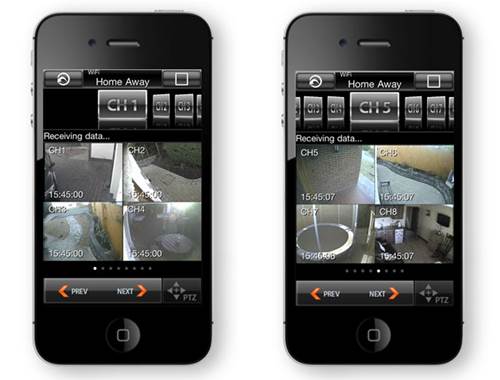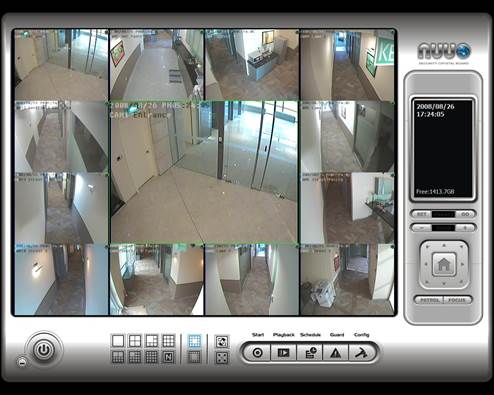Homes and small businesses have just as
much need for physical security as their warehouse and data center
counterparts. But smaller organizations may not have the on-staff expertise or
budget for a high-end security deployment. If this sounds like your situation,
don’t worry. There are plenty of affordable ways to set up surveillance in your
setting, and it doesn’t take a computer scientist to handle the networking.

A
basic surveillance system includes cameras, network adapters for connecting
them to your LAN, and software to make it all work on your PCs and mobiles
The first thing to remember is that you’ll
likely have a much easier deployment, as well as more functionality for less
money, if you opt for a surveillance system based on IP (Internet Protocol)
networking rather than older, analog CCTV (closed circuit television)
technology. CCTV still dominates in many stores, and professional security
installers may opt for CCTV as a first choice because it’s where they have many
years of experience. But you want digital, and we’re going to show you why by
examining a few security options.
Elements of a solid surveillance kit
There are three basic things you want a
security package to do:
1.
Provide remote visibility into a given area.
2.
Detect and record intruders.
3.
Alert you, preferably via multiple means, if an
intrusion is detected.
We’ll illustrate each of these three
shortly, but know that you can have these three things for well under $200. You
can begin with a free surveillance application and a couple of sub-$100 IP
cameras. Ethernet-only cameras cost less than cameras with Ethernet and Wi-Fi,
so for low-cost options, you’re probably looking at wired cameras. The upside
of wired is that video streams will be less prone to distortion, dropped
frames, and stream interruptions; plus, the setup process is simpler.
However, cheap cameras may not give you all
of the functionality you’ll eventually want, so let’s talk about desirable
features.

Many
cutting-edge security systems offer the ability to view and manage surveillance
video streams from your smartphone
Resolution.
If you’ve ever compared a Blu-ray movie to its VHS counterpart, you know what a
difference higher resolution can make. The more resolution (higher pixel count)
you have, the more detail you get in a given field of view. If all you care
about is seeing if an intruder is in an area, even a resolution of 320 x 240
will be sufficient. But if you want to make out the intruder’s facial features
or capture a license plate number, you’re going to need more pixels.
Optics. The
quality of the lens can have a significant impact on the surveillance image you
see. Unfortunately, quality is subjective, and there are no simple ways of
grading lens quality in cameras. Still, generally speaking, a $300 camera will
provide better optical quality (and thus better image clarity) than a $100
camera, all other factors being equal. The quality of the sensor that records
the images from those optics also plays a role in image clarity.
Audio. A camera with an integrated
microphone will let you hear what’s being said or done in the camera’s
environment. Some cameras offer a port for plugging in an external microphone;
this usually adds overall cost but can yield superior audio clarity. Also note
that some cameras include speakers, enabling two-way conversations between you
and the people being observed and/or the playback of a recorded alert in the
event an intrusion alarm is triggered.

Infrared
LEDs such as this one emit invisible infrared light that infrared-capable
security cameras can use to secure the premises, even after hours
Movement.
Most low-end cameras are fixed-position. Wherever the lens points, that’s what
you see. However, many mid-range cameras incorporate motorized panning (side to
side) and tilting (up and down) that you can control remotely. When trying to
cover a broad area with only one or two cameras, “PT” capability is extremely
useful. Higher-end cameras may offer optical zooming, just like on handheld
still and video cameras. This feature is most useful in environments that are
being actively monitored throughout the day. Note that some cameras may try to
emulate PTZ (pan-tilt-zoom) functionality digitally. This involves isolating a
central part of an image, then scooting the borders of that cropped area around
within the original image. You can’t see any additional detail with digital
PTZ.
Remote storage. When triggered by an alert, some security cameras can store video
directly into an inserted flash memory card (usually Secure Digital type). This
enables video capture even if Internet connectivity is lost. Preferably,
though, you want to store video away from the camera first, then on the camera
as a backup measure. Some cameras can stream recordings directly to an FTP
(File Transfer Protocol) site, but most will relay streams back to a PC running
a client application.
Night vision. Cameras with excellent sensors may be able to capture clear images
in very low light conditions, but in our experience, these are nearly useless
for surveillance because shutter speeds become so slow. If the camera is only
capturing two frames per second in near-dark conditions, any recorded movement
is likely to look like a smear. The better approach is to use a camera with
infrared lamps. Infrared is invisible to the eye, but most camera sensors treat
it like regular light, so you get greenish/gray night vision footage. Even if
your camera doesn’t integrate IR lamps, you can always buy a separate IR lamp
and point it within the camera’s field of view.
Other options
As mentioned earlier, it is possible to
begin with a single camera and free surveillance software for well under $100.
Going the other way, you can get some valuable extras by spending a little more
money.

Good
surveillance system software gives you plenty of control over the cameras and
devices in your security network
Some DIY surveillance kits utilize their
own proprietary wireless networking technologies to communicate with your
building’s wireless LAN and to network any of the included or optional security
devices. Some of the possibilities include touch-code door locks, window-break
sensors, a climate control pad, surveillance cameras, motion detectors,
lighting or small appliance switches, and more. Typically, a professional
installer will deploy any purchased devices and perform the networking setup,
including making sure that you have Web- and phone-based access to the whole
system.
For example, a triggered alarm may indicate
that someone is at your front door. You can view a live video feed of the
entrance and not only disarm the security system but also unlock the door, all
from your phone. Another extra you might be willing to spend to get is a
battery backup and connection to a local cellular service provider, averting
the risk of a break-in going unreported if the power and broadband lines are
cut. Also look for a silent alarm capability, which allows you to call for help
even when it looks like you’re disarming the system.
Whether it’s security service or a
surveillance system you’re looking for, you can get what you need either in a
complete kit or piecemeal. The distinction is an important one for people to
consider before making an investment. Also, don’t forget to factor in
installation costs, as well as any monthly fees that you might incur by
selecting one service over another. Whether you opt for a basic DIY approach or
a full-blown security system, you’ll find today’s offerings more flexible,
affordable, and feature-rich than ever.